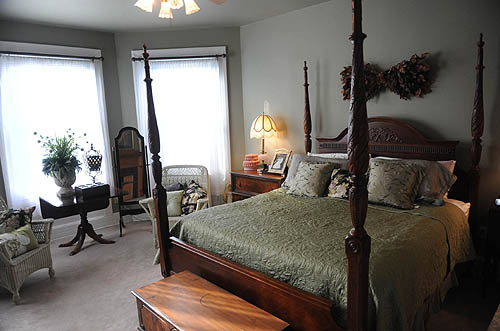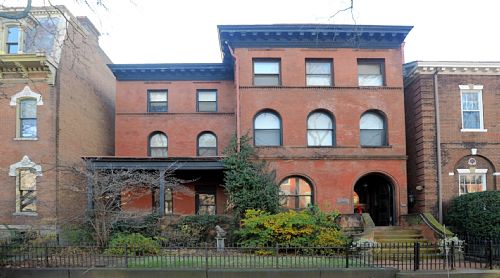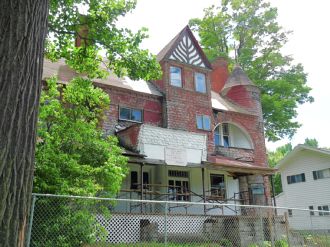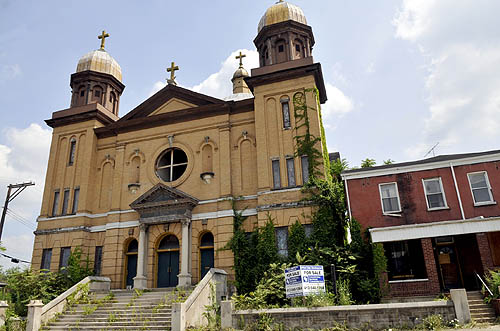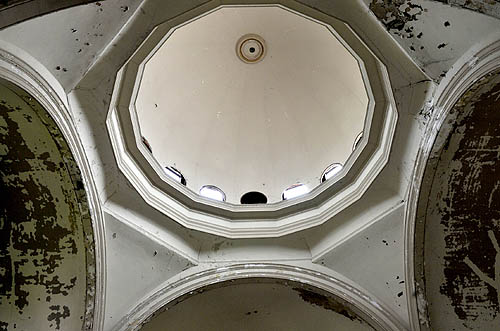
Category Archive: Pittsburgh Post-Gazette
-
Public Gets Hands-On With Ideas for South Park Fairgrounds
Thursday, December 09, 2010By Margaret SmyklaThe public put its money where its mouth was during a public meeting last week about the future of the South Park Fairgrounds.
Everyone in the audience was given $500 in fake money to play a kind of board game, placing the “money” on an element that the player thought was a priority.
Elements receiving heavy play included removing Schoonmaker Hall, improving the oval fields/track surfaces and enhancing the park gateways.
A popular write-in item was “improving bathrooms.”
The input from this meeting, as well as another public meeting in September and focus groups and an online survey will be incorporated into a report from GAI Consultants, of Homestead, that is planned for completion at month’s end.
The study is supported by the Richard King Mellon Foundation, the Heinz Endowments and the county.
While there is no money in hand for improvements, the county is more likely to receive funding from foundations, and the state and federal governments, if a plan is in place, said county parks director Andy Baechle. There is no timetable.
The process was set in motion through a master plan created several years ago for all nine county parks. One of its recommendations was the formation of a nonprofit parks foundation to which tax-deductible donations could be made.
That done, the master plan was again addressed, such as its call for a detailed vision of the 76 county-owned acres from Corrigan Drive to McCorkle Road encompassing the Fairgrounds, exhibit hall buildings, amphitheater, police barracks, Nature Center, tennis/basketball courts, and more.
“This area has a tons of potential, but it has lagged,” said Jeaneen Zappa, the Allegheny County’s sustainability manager.
At the meeting, three options — titled “Modified,” “Campus” and “Picturesque” — were presented to solicit comments from the audience.
The “Modified” option is based on what can be done fairly easily and economically, such as removing/repairing bleachers, improving oval fields/track surfaces and enhancing park gateways.
With “Campus,” which emphasizes pedestrians, the recommendations include removing Agricultural Hall for additional parking, adding a “green” parking lot at McCorkle and Brownsville roads and reclaiming the southern end of Catfish Run.
“Picturesque” focuses on the naturalistic quality of the park’s original planning, such as reconfiguring the oval track to curvilinear shape, relocating the tennis/basketball courts and relocating the nature center adjacent to Catfish Run.
Ms. Zappa said the final report will likely include elements of all three,
Christine Fuller, executive director of the Allegheny County Parks Foundation, said the organization will review the final report and work with the county on the next steps.
After the meeting, Jeff Danchik, director of the Mon Valley Express, a drum and bugle corps which leases space from the county at Brownsville Road and Corrigan Drive, said the area needs more attractions, such as a craft shows or flea markets.
“A lot of people don’t know we’re here,” Mr. Danchik said.
Walt Sackinsky of South Park said he would like to see the infrastructure addressed, such as aging water, gas, and sewer lines, and fire hydrants.
For Terry Tressler of South Park, priorities include improvements to Corrigan Drive such as adding a middle turning lane with room on each side of the road for walkers and bikers.
His wife, Donna Tressler, would like to see Schoonmaker Hall, which is used for storage, razed. “It is falling down and dangerous, with kids going in and out,” she said.
A big priority for both is improving the bathrooms.
The couple, lifetime park users, are hopeful for change after attending both public meetings.
“I’m impressed with the caliber of people who seem to want to improve the park,” he said.
-
Buying Here: Bellevue
Saturday, December 04, 2010By Rosa Colucci, Pittsburgh Post-Gazette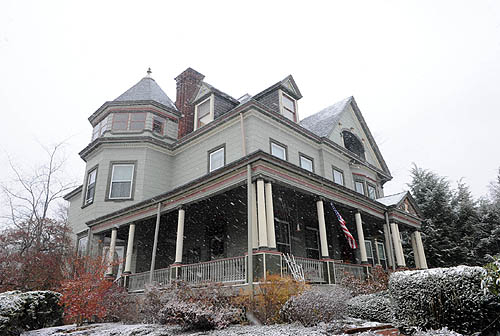
This five-bedroom, 4 1/2-bath home in Bellevue has 5,500 square feet of living space. Michael Henninger/Post-Gazette
“It takes my breath away every time I walk through the front door. It’s a warm, wonderful house,” says Sharon Hruska of her house in Bellevue.
There are very few houses that can evoke that feeling, but she isn’t exaggerating. Her five-bedroom, 4 1/2-bath Queen Ann-style house at 108 Meade Ave. (MLS No. 841177) is on the market for $299,000 through RE/MAX Realtors Don and Kathy Seaton (724-933-6300, ext. 664; or www.seatonteam.com).
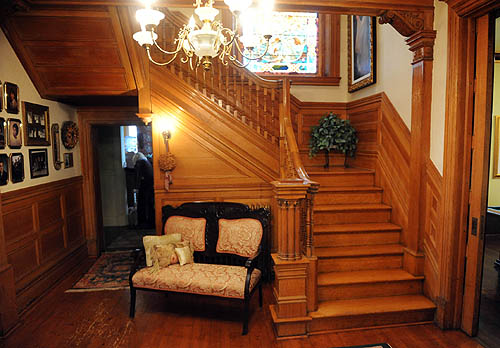
The home was built in 1898 by a lumber mill owner, who spared no expense on the wood work, including the entryway that has a carved oak staircase. Michael Henninger/Post-Gazette
When you open the front door, you are greeted by a 30-by-8-foot entryway that features a carved staircase in gleaming oak. The home was built in 1898-99 by Michael Simon, who owned a lumber mill and spared no expense.
When Sharon and Ken Hruska purchased it in 1993 for $40,000, its more than 5,500 square feet of living space was divided into nine apartments. The splendid foyer and all other woodwork were painted white. The couple spent a year restoring the home before moving in.
“My husband stripped the foyer. It took him one solid year; he worked every single day,” Mrs. Hruska said.

There is plenty of room to entertain in the 19-by-16-foot family room. Michael Henninger/Post-Gazette
This and other labors of love are evident in every nook and cranny of this grand home. The main living level has six fireplaces and an assortment of rooms perfect for entertaining. The living room (parlor) measures 18 by 16 feet and has 9-foot ceilings, tall windows and a picture rail. The 19-by-16-foot family room has a carved fireplace and a more masculine feel, decorated in traditional leather. The dining room (26 by 15 feet) has a pair of chandeliers and another fireplace, this one with a ceramic tile hearth offsetting the hardwood floors that cover most of the first floor.
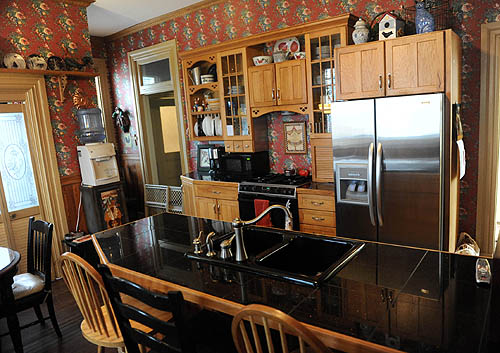
The 27-by-15-foot kitchen has granite counters and stainless-steel appliances. Glass-front cabinet doors flank the cooking area and accent exposed shelving. Michael Henninger/Post-Gazette
The 27-by-15-foot kitchen is a cook’s dream, with granite counters, stainless-steel appliances and an exposed-brick wall that nicely complements the modern appliances and amenities. Glass-front cabinet doors flank the cooking area and accent exposed shelving.
Nearby is the 18-by-16-foot den that doubles as a billiards room. Rounding out the main level is laundry room that measures 16 by 16 and a powder room.
A back staircase offers access to the huge third floor that could be rented as a full apartment. The space has three bedrooms, a full kitchen, living room and full bathroom.
Going up the front staircase to the second floor, be sure to stop to admire the majestic stained-glass window that the homeowners were able to retrieve and put back in place years after they bought the house.
The master bedroom has a trio of windows, a full master bath suite with a jetted tub that faces a fireplace, a stand-alone shower and a pedestal sink. There are two more full bathrooms and two more bedrooms (one of which is being used as an office). Room sizes range from 14 by 14 feet to 17 by 16 feet.

The master bath has a jetted tub that faces a fireplace, a stand-alone shower and a pedestal sink. Michael Henninger/Post-Gazette
The home is heated by radiator heat and cooled by room air conditioners, which stay with the home. Outside, the stunning wrap-around porch could entertain 50 people. The homeowners added a separate three-car garage to accommodate family and friends.
Now planning to downsize, the Hruskas say their grandchildren don’t want them to leave this house and friendly neighborhood, where many young families have moved recently. The house is open by appointment.
The property has a full market value of $155,000 (www2.county.allegheny.pa.us/RealEstate). In the past three years, four properties have sold on Meade Avenue ranging in price from $48,900 in April 2010 to $113,000 in June 2008 (www.realstats.net).
“Sometimes you go in big old houses [and] they have a creepy, scary feeling,” Mrs. Hruska said. “We have always felt at home here since the day we walked through the front door.”
 Bellevue
Bellevue
At a glance- Website: bellevueboro.com
- Size: 1.1 square miles
- Population: 8,770 (2000 census)
- School district: Northgate (northgate.k12.pa.us)
- Enrollment: 1,294
- Average 2010 SAT scores: 476 verbal; 494 math; 470 writing
- Current taxes on 108 Meade Ave. (full market value of Strong55,000): $6,019
- Municipality: $1,085 (7 mills)
- School district: $4,278 (27.6 mills)
- County: $656*
- Wage tax: 1 percent, split between municipality and school district
- A little bit of history: Like many northern suburbs, Bellevue originally was part of the Depreciation Lands reserved for Revolutionary War veterans. It has the distinction of being incorporated in 1876 only after Frankie East was born. Frankie’s birth gave the town a population of 300, the necessary prerequisite for residents to file a petition for incorporation with the Allegheny County Court of Quarter Sessions.
*Includes the Act 50 Homestead Exclusion, which reduces assessed market value by $15,000 for county taxes.
-
Allegheny West’s Annual Holiday House Tour Shows Off Style, Taste and City History
Saturday, December 04, 2010By Patricia Lowry, Pittsburgh Post-GazetteOn Thanksgiving eve, when I called Alex Watson about previewing his house for next weekend’s Allegheny West Victorian Christmas House Tour, I assumed it would be too early to see it in holiday garb.
“Oh, that won’t be a problem,” he said. “My Christmas tree has been up for three years.”
When your house has been on the tour for 28 of the event’s 29 years, leaving the artificial tree up and decorated in a corner of the library seems the expedient thing to do.
Next to it, on the mantel, stands the illuminated Dickens Christmas village Mr. Watson made decades ago of fiberboard, crowned by London’s St. Paul Cathedral and complete with Scrooge & Marley’s counting house. It’s now a year-round feature, too.
And next to that, on the wainscot ledge, stand a dozen smaller buildings closer to home, representing Allegheny West houses that have appeared on neighborhood tours. He and his neighbors made those, too, for sale to tour-goers in years past.
Anything to support his beloved Allegheny West, the North Side neighborhood in which he and his late partner, Merle Dickinson, settled in 1960, when they purchased the North Lincoln Avenue home. Then broken into 17 (now 10) apartments, it was far from the showplace it is today.
The red brick house, originally a two-story built between 1864 and 1865, was enlarged to its present three-story size and Romanesque Revival appearance in the early 1890s, when a library also was added to the front of the house.
Grain merchant John W. Simpson was the original owner; Joseph Walton bought it in 1888 for daughter Ida Walton Scully and her husband, glass manufacturer James Scully. In 1917 the house was sold to James S. Childs, a shoe, rubber and leather wholesaler whose wife Alice was Ida Scully’s sister.
In 1923 the house changed hands again; the new owners were Samuel and Margaret Crow, who lived there and rented rooms to boarders. The house stayed in the Crow family until 1960.
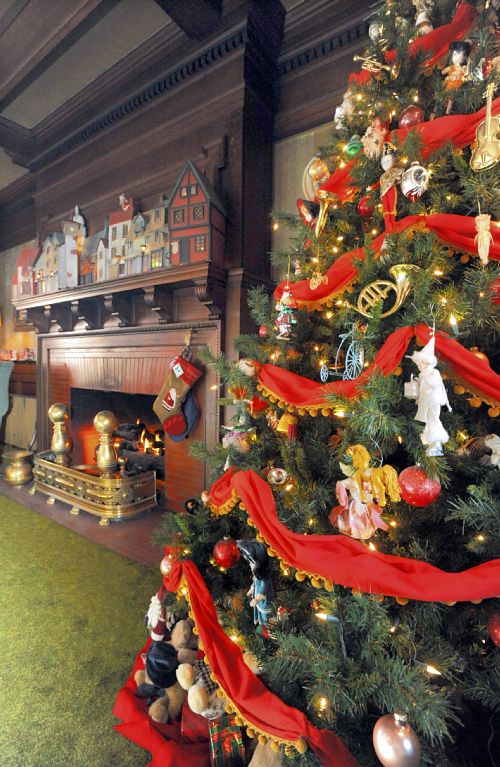
The library in Alex Watson's North Lincoln St. home is decorated for the holidays. Bob Donaldson / Post-Gazette
The house’s architect is unknown; none surfaced during architectural historian Carol Peterson’s extensive house history research. Mr. Watson thinks it may have been Longfellow, Alden and Harlow, who in 1889 completed a house across the street commissioned by B. F. Jones for his daughter Elizabeth and her husband, Joseph O. Horne, son of the department store founder. It’s a good bet, considering the richly carved and paneled oak interior finishes, the melding of medieval and classical influences and a first-floor layout similar to the Horne house. The firm designed 13 buildings within a radius of several blocks and Frank Alden had lived just around the corner.
Restoring the home’s original features became a decades-long passion for Mr. Watson and Mr. Dickinson, who did much of the work themselves. And there was much work to do. While most of the interior woodwork remained, the first floor’s front parlor, library and dining room had been its own apartment with kitchen and bath.
One bathroom occupied a corner of the entrance hall; during its removal, the owners discovered a long-lost corner of the hall’s original mantel. From that remnant, they re-created the mantel and over-mantel and warmed up the room with a gas fireplace.
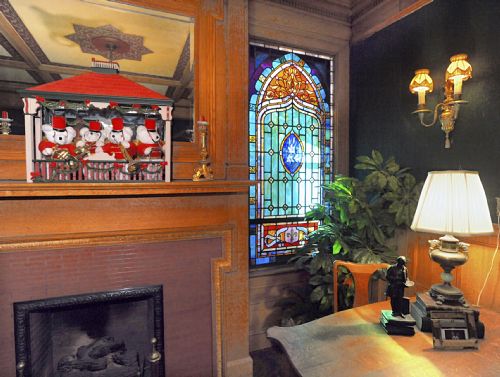
The hallway in Alex Watson's North Lincoln St. home is decorated for the holidays. Bob Donaldson / Post-Gazette
Mr. Watson has his regrets, including removal of a mantel and overmantel in the front parlor to gain wall space. They recycled it as a bar and back bar in the former kitchen, now a game room outfitted as a bordello dedicated to 1920s neighborhood madam Nettie Gordon. Eventually, in atonement, they purchased a white marble Italianate mantel from a Sewickley house sale for the front parlor.
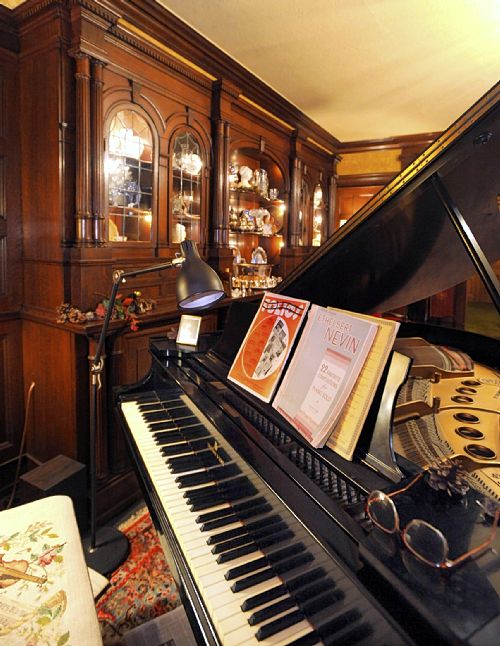
The music room in Alex Watson's North Lincoln St. home. Originally the home's dining room, the breakfront still dominates the room. The home will be on the Allegheny West Christmas House Tour. Bob Donaldson / Post-Gazette
In the former dining room, now the music room, Mr. Watson (on the piano) and friend Mark Schumacher (on the organ) plan to greet tour-goers, as they have in years past, with songs of the season. Seeing the faces of visitors as they enter the room, Mr. Watson said, “makes the whole thing worthwhile.”
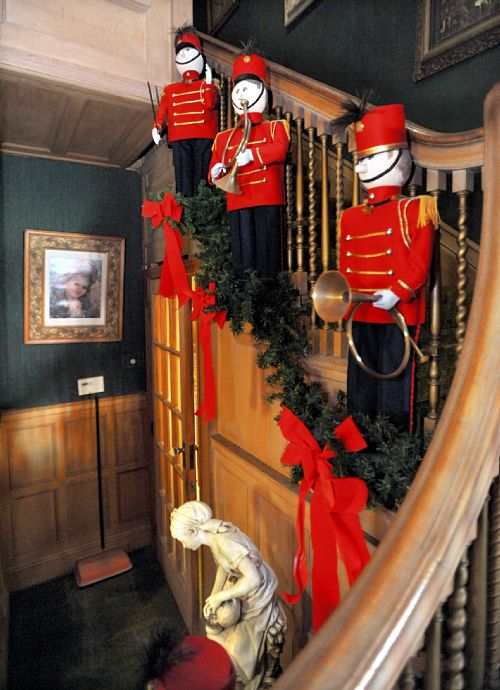
The hallway in Alex Watson's North Lincoln St. home is decorated for the holidays. Bob Donaldson / Post-Gazette
Trained in nursery and landscape management at Michigan State, Mr. Watson managed the garden shop at Sears for 27 years before it became part of Allegheny Center. His courtyard garden, glimpsed through the oak-paneled music room windows, has been featured on neighborhood garden tours; this time tour-goers will pass through it as they leave.
The six houses on the tour, spread over three blocks, include Gretchen Duthoy’s red brick, Second Empire-style Beech Avenue home, a newbie to the event.
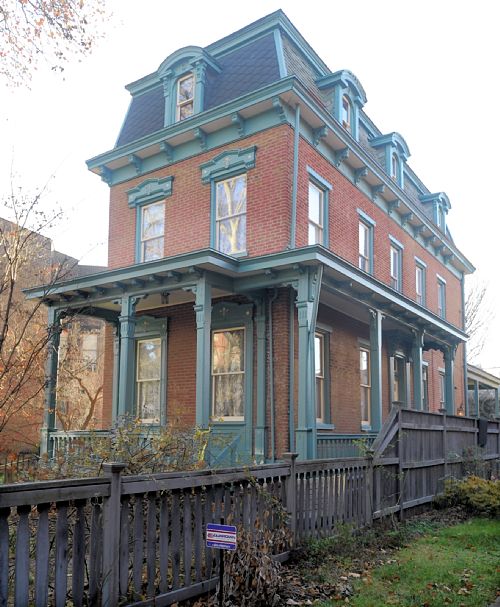
This home at 849 Beech Ave. will be on the Allegheny West Christmas House Tour. Bob Donaldson / Post-Gazette
“My house was turning 150 this year,” said Ms. Duthoy, who wanted to do something to mark the occasion. She commissioned a house history from Ms. Peterson, who discovered the house in fact was 140 years old, having been built in 1870 for railroad conductor Theodore Gray and his wife Annie. The longest ownership — 1887 to 1922 — came with four generations of the family of Christian Stoner, partner in a Strip District lumber mill.
When Ms. Duthoy, an Alcoa employee who grew up in suburban Maryland, bought the house in 2003, it had been restored by its previous owners, for whom she’d worked as a baby sitter in college.
“That’s how I came to know the house and the neighborhood and that’s how I came to live there” a few years later when they had outgrown it, she said.
Her work on the house has been cosmetic, including a kitchen update. For the tour she’ll hang family ornaments on her live tree and decorate extensively with fresh greens.
The tour, she said, is “a great showcase for the neighborhood, and I’d like to do my part.”
Allegheny West Victorian Christmas House TourInformation: Guided walking tours cost $25 per person and leave from Calvary United Methodist Church, Allegheny and Beech avenues, at 12-minute intervals from 5 to 8 p.m. Friday, and 10 a.m. to 8 p.m. next Saturday, with a maximum of 25 guests per tour. Tour guides will talk about 19th-century holiday traditions and the history of the neighborhood and the homes on the tour.
At the end of the event, which lasts about three hours, tour-goers can visit John DeSantis’ miniature railroad village and toy train collection at Holmes Hall, 719 Brighton Road, for an additional $10, as well as the Holiday Shoppe at Jones Hall, with antiques, gifts and handcrafted items. Mr. DeSantis’ train collection, open to the public only during the Christmas tour, also can be visited separately; hours are 7:30 to 10 p.m. Friday and 12:30 to 10 p.m. Saturday.
Special tours include a wine tour at 6 p.m. Friday, with wine tasting and hors d’oeuvres at a private residence, followed by the house tour ($75 per person). On Saturday, brunch tours will be offered at 10 and 10:30 a.m. and high-tea tours at 3 and 3:30 p.m. ($50 per person), followed by the house tour. With help from The Center for Hearing and Deaf Services, a signed tour will be offered at 3:36 p.m. Saturday ($25 per person).
Tours are rain or shine, snow, sleet or hail. As the Allegheny West Civic Council’s website puts it, “This is Pittsburgh and bad weather is part of the charm.” Reservations are required for all tours and tickets are nonrefundable. Visit the website (alleghenywest.org) or call 412-323-8884.
-
110-Year-Old Voting House on the Move in Derry Township
Thursday, December 02, 2010By Margaret SmyklaOne-room cabin will be preserved
The welcome mat outside the Simpson Voting House in Derry Township should read “Home Sweet Home” after the 110-year-old structure’s scheduled relocation this week by Westmoreland County.
Its new site is just a mile away in New Alexandria, less than two miles from the intersection of Route 982 and Route 22.
“This move will save it forever,” said Bob Reintgen, a member and former president of the Derry Area Historical Society. “It will be on land donated to the county. [Since] the house is also owned by the county, the county will do maintenance and take care of it.”
The one-story, one-room cabin on private land was built for voting at a time when the county was largely rural and voting houses were common. Machines were brought in on Election Day each year and taken away at day’s end.
As the number of voting houses dwindled, the Simpson Voting House, despite falling into disrepair, continued to be used until 2003.
“It is the only county-owned voting house still in existence, so it is a gem,” said Mr. Reintgen of Latrobe.
The move will cost the county less than $15,000, with the preparation work done by the Public Works Department.
“We’re working on plans now to restore it so that the people of the Simpson District may vote in it again,” county Commissioner Ted Kopas said.
“We think it is important to honor the heritage of this county and a forgotten period when people voted in voting houses.”
About 15 years ago, Mr. Reintgen, a retired history teacher, directed his students in a project to paint the house and perform other tasks in an effort to reverse the deterioration.
Afterward, without maintenance and with animals using it for shelter, it fell into disrepair again, despite the society’s work to give it a new roof and siding and remove a wall to rid it of bees.
Nine years ago, the group learned that the state Department of Transportation was going to widen Route 22 to four lanes and was planning to tear down the house, which stood on the land for one of the new lanes. The organization began its campaign to relocate the house.
“It was a struggle, as you can guess with the county, the society and PennDOT involved,” said Evelyn Baker Ruffing of Derry Township, vice president of the historical society.
The new site will be in a park-like setting and will have modern restrooms and a parking lot and be accessible to handicapped people.
The old-fashioned flavor of the century-old building — such as the coal stove in the center of the room –will be retained, Mr. Reintgen said.
“We’ll have to work our touch-screen voting machines around it,” he said of blending the old and new.
The original outhouse, which is in need of a new floor, will be erected for display purposes only.
The historical society will lend its assistance and guidance with the project.”Hopefully, the county will shepherd the building throughout the 21st century,” Mr. Reintgen said.
-
‘Isaly’s Building’ in Irwin Saved by Main Street Deli
Wednesday, November 24, 2010By Norm VargoLou Botti is realizing a childhood dream.
“I used to love it as a kid when my family went to shop in Irwin. I knew we would end up at Isaly’s for an ice cream,” recalled the North Huntingdon contractor.
“I would think to myself: Someday I’d like to own an Isaly’s.”
It’s not an iconic Isaly’s, Mr. Botti, 41, now owns. It’s the landmark Hamilton Building along Main Street, which many in town still call “Isaly’s.” For 43 years it housed the immensely popular dairy store, deli and bakery until it closed in 2004.
Earlier this month, Mr. Botti opened the Main Street Deli and Bakery in that space. The store offers cold deli sandwiches, pies, assorted pastries baked on the premises, milk, bread, buns, lunch meats, cheese and ice cream, the Hershey brand.
Mr. Botti plans to add a full kitchen later.
The interior was renovated to give the deli a retro look. A meat slicer left from the old Isaly’s sits on the back shelf.
The familiar white slate marquee sign with the black script lsaly’s logo remains.
“The sign is not intended to mislead people. I don’t own an Isaly’s, I don’t sell Isaly’s products,” Mr. Botti said. “It’s that the sign has a historical significance in Irwin’s downtown. The dairy store-deli was a destination for folks. Old-timers still call it “Isaly’s.”
“Lots of memories are in there, including mine,” Mr. Botti said.
“Customers keep bringing in mementos and souvenirs from the old Isaly’s. They want to share their treasures with me. It’s unbelievable,” he said.
A little history:
The late Art Lewis founded a dairy store in Irwin 65 years ago. The business outgrew its building.
When the Hamilton Building in the heart of downtown became available, he bought it.
About that time, Isaly’s began franchising. Mr. Lewis recognized the potential for a dairy store-deli in Irwin. He negotiated a franchise that would become so popular that he opened another Isaly’s in the Norwin Shopping Center in North Huntingdon.
Bakery goods were baked in the Irwin Isaly’s daily and delivered to the other store. Mr. Lewis retired in 1986 and sold that business to concentrate on the Irwin store.
Potential deals to purchase the three-story brick Isaly’s Building and the delicatessen, which was being operated by family members, fell through.
The structure deteriorated. Borough officials were considering condemnation.
“What council didn’t want to do was to tear down that landmark building and leave a vacant lot right in the middle of the downtown business district,” said Councilwoman Danyce Neal.
“We all were hoping somebody would buy it and restore,” Ms. Neal said.
Urged by Donn Henderson, the Irwin Main Street manager, Mr. Botti purchased the building in 2007.
He immediately corrected a multitude of building code violations to make the structure sound.
Then he renovated four apartments on the upper floors. All were rented before completion.
“I really was interested in those apartments,” said Mr. Botti, who estimated he “has put about $300,000” into the building.
“My initial plan was to find somebody to put in a deli,” he continued. “Three investors looked at it, but no deal materialized.
“I figured three years was long enough to wait. I decided to open one.”
Mr. Henderson said he hoped the deli would attract investors to invest in other businesses in the community.
For details, call 724-515-5525.
-
Jones’ Cresson Home May Avoid Razing
Saturday, November 20, 2010By Patricia Lowry, Pittsburgh Post-GazetteThe Cresson Area Historical Association, which has owned the 14-room, Queen Anne-style house since 1990, has a tentative agreement to sell it to Andrew and Carrie Dziabo, who grew up nearby and live just a few minutes away.
The tentative agreement, reached Friday, appears to have the blessing of Cresson Township supervisors, who heard the couple outline their plans at a township meeting earlier this month.
“We’re still working on it,” said Mr. Dziabo (pronounced zay-bo). “There are issues that need to be worked out, but it’s looking promising.”
The dilapidated house has been under threat of demolition since a Cambria County judge approved its razing in late 2008. Supervisors had told the historical association the house could be torn down after Sept. 30.
A member of the historical group wrote in an e-mail that the house would be sold for a nominal fee, with the new owners also paying the township’s legal expenses incurred during the long court proceedings. Mr. Dziabo referred questions about sale price to the township solicitor, who was unavailable Friday.
Mr. Dziabo grew up a block away from the Jones cottage, in a historic house that also was part of the Mountain House resort grounds. He worked with his father, civil engineer Michael Dziabo, on restoring that house, and the two plan to collaborate on this one.
While Andrew Dziabo, who works for a power company, has admired the Jones house since he was a child, it wasn’t until the historical group offered tours in the spring that he was able to see the interior.
“The house isn’t in as bad shape as I thought,” he said. “It’s actually very sturdy inside. There is some water damage that ate the plaster in a lot of the rooms, but as far as the structure goes, it seems pretty sound and sturdy. The floors don’t even creak.”
The Dziabos intend to restore the exterior and preserve as much of the interior woodwork as they can.
“The whole appeal of it to my wife and me is the character of the Victorian-style home,” he said, adding that its ornate, well-preserved foyer and staircase “would be very easy to restore. It’s just a matter of elbow grease.”
The Dziabos expect to know soon whether the Jones cottage is theirs.
“The township wants to have this issue to bed by the next [supervisors] meeting.”
-
Unusual Touches Mark Phipps’ Winter Show
Saturday, November 20, 2010The Winter Flower Show opens Friday at Phipps Conservatory and Botanical Gardens in Oakland. Nine of the indoor gardens will be bedecked with topiary snowmen, decorated trees, hanging baskets, thousands of lights and more than 2,000 poinsettias. Newer varieties of poinsettias will be on display, including ‘Polar Bear,’ ‘Winter Blush,’ ‘Ice Punch,’ ‘Visions of Grandeur’ and ‘Tapestry.’
Also on display is the garden railroad with operating trains and miniature living scenery that includes dwarf conifers. The show, which runs through Jan. 9, was designed by the conservatory staff with help from Michele McCann.
“The show is a wonderful combination of horticulture and whimsy, with beautiful new poinsettias and common annuals used in unusual ways,” says Margie Radebaugh, Phipps’ director of horticulture and education.
Special seasonal events include:
• Visits by Santa Claus on Saturdays and Sundays through Dec. 19.
• A “Garlands & Gifts” sale on Dec. 2-3 from 10 a.m. until 7 p.m.
• Phipps stays open until 10 p.m. daily, beginning Dec. 6, with candlelit walkways and live entertainment.
Admission is $12 for adults; $11 for seniors 62 and older and students with valid ID; $9 for children ages 2 to 18; free for children under 2. Information: www.phippsconservatory.org or 412-622-6914.
-
Buying Here: Larimer
Saturday, November 20, 2010By Gretchen McKay, Pittsburgh Post-GazetteOur Lady Help of Christians in Larimer was barely 5 years old when fire ripped through it in 1905, destroying the church at the corner of Meadow and Turrett streets. The Italian immigrants who had guided its construction in 1898, though, were a resolute bunch.
Within a year they’d rebuilt the Baroque-style structure, and until it closed in 1992, Help of Christians served as a center of Italian-American religious and social life, hosting not just Catholic Masses but everything from the annual celebration in honor of St. Agnello Abate to an array of sporting activities for neighborhood kids.
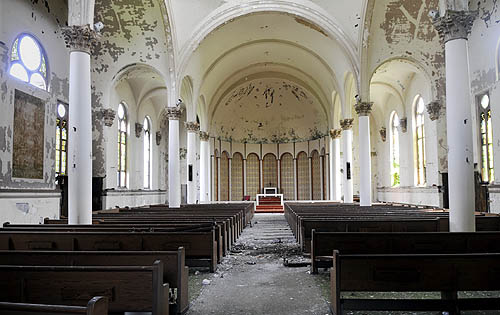
The ceiling and plaster walls have peeling paint at the former Our Lady of Help Christians church in Larimer. J. Monroe Butler II/Post-Gazette
Like many churches in the city, however, its parish aged and dwindled and was merged in the 1990s with five others to form St. Charles Lwanga parish in Lincoln-Lemington. In 1995, the Pittsburgh Catholic Diocese sold the church, which has a banquet hall in the lower level, and adjacent rectory to Heavenly Vision Ministries.
Three years ago, Heavenly Vision put 6513 Meadow St. back on the market, at first quietly through word of mouth, and then last year officially for $169,000 through Coldwell Banker Real Estate’s Fox Chapel office (www.pittsburghmoves.com; MLS No. 838378; 412-963-7655).
 Larimer
Larimer
At a glance- Website: www.city.pittsburgh.pa.us/district9/
- Size: .445 square miles
- Population: 2,602 (2000 census)
- School district: Pittsburgh Public, pghboe.net
- Enrollment: About 28,000
- Average 2010 SAT scores: (Peabody High School) 379 verbal; 410 math; 380 writing
- Taxes for a property assessed at $100,000 *: $2,870; City: $1,080 (10.8 mills); School district: $1,392 (13.92 mills); County: $398 (4.69 mills)
- Wage tax: 3 percent (1 percent to the city, 2 percent to the school district)
- Bet you didn’t know: Originally settled by Germans in the mid-1800s, Larimer was Pittsburgh’s “Little Italy” until the 1960s. It is named for railroad magnate and radical abolitionist General William Larimer, who built a manor home overlooking East Liberty along a path that would eventually become known as Larimer Avenue.
* Includes the Act 50 Homestead Exclusion, which reduces assessed market value by $15,000 for county taxes.Time has not been kind to Help of Christians, which could accommodate up to 1,000 worshippers in the nave and balcony in its heyday in the ’50s and ’60s. The amount of repairs necessary to breathe life back into the property are pretty extensive.
There is no glass in its long, arched windows and holes in the roof. The coved ceiling and plaster walls are peeling paint. Vandals have broken the pews and stolen the pipes from the organ. Carpeting is matted with dust, debris and pigeon feathers. The hand-painted frescoes that brightened the chancel are so badly faded and tarnished you almost can’t tell they were ever there. There’s no heat or water.
“People go in an ooh and aah over the architecture, but it’s a broken structure,” says Realtor Ted Harchick, who shares the “as-is” listing with Dan Boehler.
Adding insult to injury are the many thefts that have stripped the space of most everything of architectural significance. Only a handful of the dozens of original stained-glass windows remain. And it’s only because they’re too heavy to lift that looters also didn’t carry away the marble communion rails in the chancel.
Most heartbreaking is the massive circular window that crowned the front door. Somehow, the robbers managed to sneak the stained glass out of the wood framing in the stealth of night.
Vandals also have trashed the 6,000-square-foot rectory, which during Heavenly Vision Ministries’ tenure housed Family Options Foster Care, in addition to church offices. The property’s current market value is $256,400 ($172,900 for the church and $83,500 for the rectory). Taxes are in arrears on the rectory.
“It’s not for the faint of heart,” admits Mr. Harchick. “We need a risk-taker.”
On the plus side is its location in Larimer. Developments such as Bakery Square, a new “lifestyle center” in the old Nabisco plant on Penn Avenue, are helping to make one of Pittsburgh’s poorest neighborhoods attractive to national retailers and other businesses. UPMC, for instance, is planning to open a technology development center there by the end of the year, and Free People, a hip clothing boutique, follows on the heels of Anthropologie this winter. Next year, a $1.8 million, 14,500-square-foot vocational center funded by the Urban Redevelopment Authority and the Small Business Administration will open not far from the church on Meadow Street.
The Rev. Armenia Johnson, leader of Heavenly Vision Ministries, says she will be very careful in selecting a buyer for the old church.
“We want them to restore it into something that is beneficial and positive for this community,” she says.
In other words, if you’re thinking “brew house” or “night club,” it’s probably not going to fly.
Rev. Johnson, who is now associate pastor of St. James Baptist in Homewood, paid $100,000 the property in 1995. Although the Garfield native did her best to maintain the elegant building, she never had the funding she needed to properly maintain or improve it. So bit by bit, the once grand structure fell into terrible disrepair.
It’s a common fate for churches, which account for a growing number of real estate listings thanks to declining membership and consolidations. According to RealSTATS, a South Side-based real estate information company, 45 churches have changed hands in Allegheny and surrounding counties since January 2009, with sales prices ranging from $5,000 for Ambassador Baptist Church in Ross to $1.1 million for Christian Community Church in Adams.
Occasionally one will make the transition from place of worship to heavenly home. But given the high redevelopment costs, it often takes a grand idea — restaurant, performance hall, multi-unit condo development — and corporate investors to fill such a grand space. CVS, for example, bought the church in Adams. Most are purchased as-is by other religious organizations, or they languish on the market for years.
“You definitely don’t have as many players,” notes Tom Conroy of Howard Hanna Real Estate Services, who has sold so many churches for Hanna’s commercial division that he’s known as The Church Guy.
Mr. Conroy’s current listings include Harvest Baptist Church in New Kensington ($199,000; MLS No. QL102931); St. Michael Church ($250,000; MLS No. QL103962) in Munhall; and St. Mary Magdalene ($159,000; MLS No. QL103653) in Homestead.
Financing, zoning and parking all can be challenges. Many older churches were built in walkable residential areas that prohibit commercial enterprises. Former parishioners add to the difficulty. Even after religious artifacts have been removed and the building is just a building, some stay emotionally attached.
“Significant events take place there,” says Mr. Conroy. “Marriages, baptisms, funerals.”

